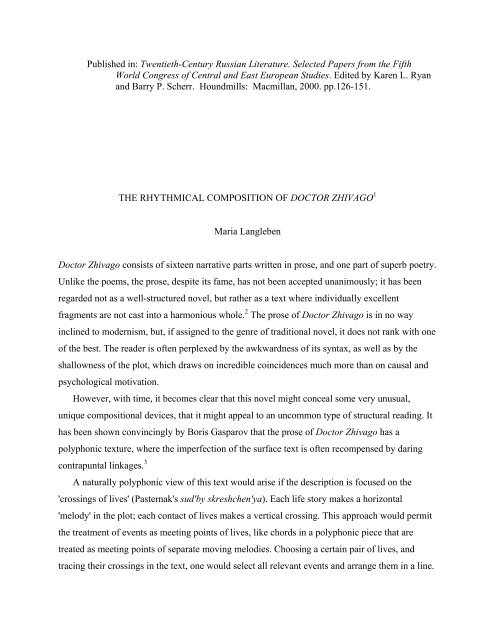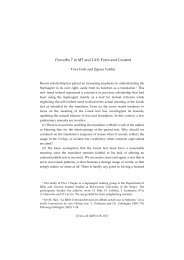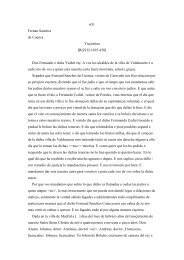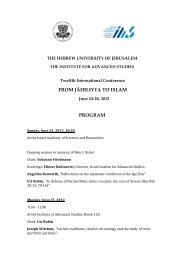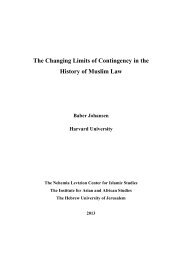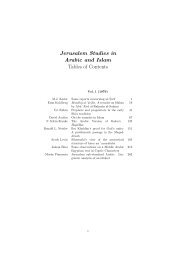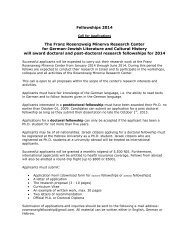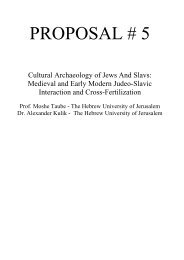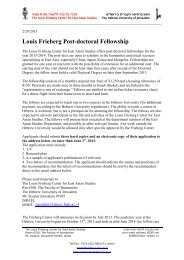Twentieth-Century Russian Literature. Selected Papers from the ...
Twentieth-Century Russian Literature. Selected Papers from the ...
Twentieth-Century Russian Literature. Selected Papers from the ...
Create successful ePaper yourself
Turn your PDF publications into a flip-book with our unique Google optimized e-Paper software.
Published in: <strong>Twentieth</strong>-<strong>Century</strong> <strong>Russian</strong> <strong>Literature</strong>. <strong>Selected</strong> <strong>Papers</strong> <strong>from</strong> <strong>the</strong> Fifth<br />
World Congress of Central and East European Studies. Edited by Karen L. Ryan<br />
and Barry P. Scherr. Houndmills: Macmillan, 2000. pp.126-151.<br />
THE RHYTHMICAL COMPOSITION OF DOCTOR ZHIVAGO 1<br />
Maria Langleben<br />
Doctor Zhivago consists of sixteen narrative parts written in prose, and one part of superb poetry.<br />
Unlike <strong>the</strong> poems, <strong>the</strong> prose, despite its fame, has not been accepted unanimously; it has been<br />
regarded not as a well-structured novel, but ra<strong>the</strong>r as a text where individually excellent<br />
fragments are not cast into a harmonious whole. 2 The prose of Doctor Zhivago is in no way<br />
inclined to modernism, but, if assigned to <strong>the</strong> genre of traditional novel, it does not rank with one<br />
of <strong>the</strong> best. The reader is often perplexed by <strong>the</strong> awkwardness of its syntax, as well as by <strong>the</strong><br />
shallowness of <strong>the</strong> plot, which draws on incredible coincidences much more than on causal and<br />
psychological motivation.<br />
However, with time, it becomes clear that this novel might conceal some very unusual,<br />
unique compositional devices, that it might appeal to an uncommon type of structural reading. It<br />
has been shown convincingly by Boris Gasparov that <strong>the</strong> prose of Doctor Zhivago has a<br />
polyphonic texture, where <strong>the</strong> imperfection of <strong>the</strong> surface text is often recompensed by daring<br />
contrapuntal linkages. 3<br />
A naturally polyphonic view of this text would arise if <strong>the</strong> description is focused on <strong>the</strong><br />
'crossings of lives' (Pasternak's sud'by skreshchen'ya). Each life story makes a horizontal<br />
'melody' in <strong>the</strong> plot; each contact of lives makes a vertical crossing. This approach would permit<br />
<strong>the</strong> treatment of events as meeting points of lives, like chords in a polyphonic piece that are<br />
treated as meeting points of separate moving melodies. Choosing a certain pair of lives, and<br />
tracing <strong>the</strong>ir crossings in <strong>the</strong> text, one would select all relevant events and arrange <strong>the</strong>m in a line.
2<br />
The line would retain <strong>the</strong> order of <strong>the</strong> plot, but, strictly speaking, it does not belong to it. Ra<strong>the</strong>r,<br />
with such lines, a meta-plot is built up which can be read as a musical score, both horizontally<br />
and vertically.<br />
The lives of <strong>the</strong> two main protagonists, Yurii Zhivago and Lara Guishar are stretched along<br />
<strong>the</strong> text; <strong>the</strong> line made by <strong>the</strong> crossings of <strong>the</strong>ir two lives is more extended and rich than any of<br />
<strong>the</strong> numerous similar lines. One can hypo<strong>the</strong>size that this line holds <strong>the</strong> clue to <strong>the</strong> composition<br />
of <strong>the</strong> novel. Proceeding on this assumption, <strong>the</strong> narrative parts of Doctor Zhivago (Parts I-XVI)<br />
are examined in this paper. 4<br />
The biographies of Yurii and Lara begin at widely separated places, geographically as well as<br />
socially. Lara is not only 'a girl <strong>from</strong> ano<strong>the</strong>r society', much lower than Zhivago's, but she is <strong>from</strong><br />
distant lands as well – Belgium, France, and <strong>the</strong> Urals, all three far away <strong>from</strong> Yurii's Moscow 5 .<br />
Their two lives gradually gravitate towards each o<strong>the</strong>r, <strong>the</strong>y part, meet again and again part, and<br />
all of <strong>the</strong>se crossings are ascribed to blind chance alone. Yet, <strong>the</strong> line of crossings may have its<br />
own structural teleology. It will be shown in this paper that <strong>the</strong> route that leads Yurii and Lara<br />
out of <strong>the</strong>ir disconnected worlds and draws <strong>the</strong>m through <strong>the</strong> text is arranged by a rhythmical<br />
fluctuation of events which has no need for realistic motivation.<br />
1 The Line of Contacts<br />
Starting <strong>from</strong> <strong>the</strong> first meeting of Yurii and Lara, we shall make a list of <strong>the</strong>ir lives' crossings, or<br />
ra<strong>the</strong>r, of all <strong>the</strong>ir contacts, leaving aside everything irrelevant to this subject. Here a broad<br />
definition of 'contact' will be used: in additiion to <strong>the</strong>ir meetings, any event that could be related<br />
to Lara's role in Yurii's life is considered relevant. Any reference to her name, recollections,<br />
letters, or discussion about her will be considered on a par with <strong>the</strong> meetings. Thus understood,<br />
<strong>the</strong> contacts listed will differ greatly in terms of Lara's and Yurii's degree of participation in <strong>the</strong><br />
events. Sometimes one of <strong>the</strong>m is absent; at o<strong>the</strong>r times, <strong>the</strong>y both are unaware (or pretend so) of<br />
each o<strong>the</strong>r's presence. At certain points, <strong>the</strong> contact is only visual or verbal (written or oral). A<br />
contact may be established indirectly, i.e., through a mediating object. On <strong>the</strong> basis of <strong>the</strong>se<br />
differences, one can characterize <strong>the</strong> contacts as relatively more intense or less intense, using <strong>the</strong><br />
following criteria:
3<br />
1. physical presence – absence;<br />
2. awareness – unawareness;<br />
3. direct – indirect;<br />
4. visual – verbal – full.<br />
Assuming that 'presence', 'awareness', and 'directness' make a contact stronger than do <strong>the</strong>ir<br />
opposites, and that a full contact is stronger than a visual or verbal contact, one can distinguish<br />
between 'stronger' and 'weaker' contacts of various degrees.<br />
In this way, a line of contacts (LC) may be compiled, in which besides Lara and Yurii, <strong>the</strong><br />
presence of <strong>the</strong>ir three spouses, Tonya, Antipov, and Komarovskii, 6 is also considered. It appears<br />
<strong>the</strong>n that stronger and weaker events alternate in <strong>the</strong> LC in a way that is hardly random: <strong>the</strong><br />
alternation generates a persistent rhythm. Yet, since Lara and Yurii first meet ra<strong>the</strong>r late in <strong>the</strong><br />
text, and die before <strong>the</strong> novel ends, <strong>the</strong> LC leaves <strong>the</strong> beginning and <strong>the</strong> end of <strong>the</strong> novel<br />
uninvolved. Assuming that <strong>the</strong> deaths of his parents constitute make a prologue to Zhivago's life,<br />
while <strong>the</strong> meeting of Evgraf and Tan'ka forms an epilogue to it, one can extend <strong>the</strong> LC to <strong>the</strong><br />
beginning and <strong>the</strong> end of <strong>the</strong> nnovel. Then one can see that <strong>the</strong> whole text yields to <strong>the</strong> regular<br />
pulsation.<br />
The extended LC is presented in Table 1.1; <strong>the</strong> grading of events is indicated in <strong>the</strong> table by<br />
shifting <strong>the</strong> entries to <strong>the</strong> left or to <strong>the</strong> right. 'Stronger' events are shifted to <strong>the</strong> left, while<br />
'weaker' ones are shifted to <strong>the</strong> right. Simultaneous events are connected on <strong>the</strong> left side of <strong>the</strong><br />
table. The events of <strong>the</strong> prologue and <strong>the</strong> epilogue are marked on <strong>the</strong> right side. Yurii, Lara,<br />
Tonya, Antipov, and Komarovskii are designated by Y, L, T, A, and K respectively. One can see<br />
in Table 1 that <strong>from</strong> <strong>the</strong> beginning of <strong>the</strong> LC, each strong event is accompanied by a several<br />
weaker ones, of various degrees of intensity. There is a point (Parts XIII-XIV), where <strong>the</strong><br />
stronger events become predominant, and <strong>the</strong>n, towards <strong>the</strong> end, <strong>the</strong> original pattern of pulsation<br />
is resumed. Ano<strong>the</strong>r notable feature of <strong>the</strong> LC is that it has its own <strong>the</strong>matic organization, which<br />
is adjusted to <strong>the</strong> pulsation and is only remotely related to <strong>the</strong> surface story.
4<br />
Table 1: The Line of Contacts<br />
Parts<br />
I<br />
II<br />
III<br />
Events<br />
The funeral of Y's mo<strong>the</strong>r<br />
The knock at <strong>the</strong> window<br />
The death of Y's fa<strong>the</strong>r<br />
L's mo<strong>the</strong>r's suicide attempt<br />
Y sees L for <strong>the</strong> first time<br />
A candle in <strong>the</strong> window<br />
Y sees L again<br />
The shot: Lara tries to kill K<br />
IV . . . . . . . . . . . . . . . . . . . . . . . . . . . .<br />
Y and L meet at <strong>the</strong> front<br />
Y meets L in <strong>the</strong> hospital<br />
V A letter <strong>from</strong> T to Y (about L)<br />
Y does not knock at L's door<br />
L is ironing<br />
The knock at <strong>the</strong> door (window)<br />
VI . . . . . . . . . . . . . . . . . . . . . . . . . . . .<br />
Y visits <strong>the</strong> house in Brestskaya street<br />
VII<br />
Y is interrogated by A<br />
VIII . . . . . . . . . . . . . . . . . . . . . . . . . . . .<br />
IX . . . . . . . . . . . . . . . . . . . . . . . . . . . .<br />
Y's dream with L's voice<br />
Y and L in <strong>the</strong> library<br />
Y and L meet near L's house<br />
Thinking of L, Y is captured by <strong>the</strong> partisans<br />
X . . . . . . . . . . . . . . . . . . . . . . . . . . . .<br />
XI<br />
XII<br />
XIII<br />
XIV<br />
Lara = Yurii's soul<br />
Lara = 'God's earth'<br />
A song of a rowan tree<br />
L's soul opened<br />
A vision of <strong>the</strong> weeping head<br />
L = a rowan tree in snow<br />
Y reads L's note to him (T is mentioned)<br />
Y and L meet in L's house.<br />
Y and L live toge<strong>the</strong>r in Yuryatin (and talk about T, A,<br />
K)<br />
T's letter to Y (L is mentioned)<br />
K arrives in Yuryatin<br />
Y and L in Varykino<br />
K arrives in Varykino<br />
K takes L away with him<br />
Y's lament for L; L's voice<br />
A and Y in Varykino<br />
The shot: A's suicide.<br />
prologue<br />
XV<br />
Y lives in A & L's room<br />
The death of Y<br />
Y's body is returned to A's room<br />
Y's funeral; L & Evgraf;<br />
The remembrance of <strong>the</strong> candle<br />
L disappeared<br />
XVI Tanya meets Evgraf Zhivago. epilogue
5<br />
2 Twelve Motivic Groups<br />
The events included in <strong>the</strong> LC are located at discrete points in <strong>the</strong> text; <strong>the</strong>y are not connected by<br />
<strong>the</strong> logic of <strong>the</strong> fabula. Yet, despite <strong>the</strong>ir narrative incoherence, <strong>the</strong> selected events cohere<br />
meaningfully within <strong>the</strong> LC. The whole LC may be divided into successive motivic groups of<br />
events, where each group has its own generalized meaning, and <strong>the</strong>se groups do not intersect. It<br />
seems that <strong>the</strong> LC tries to tell its own tale, unfettered by <strong>the</strong> surface story.<br />
To support this, let us now review <strong>the</strong> LC as it is divided into twelve motivic groups. Each<br />
group is presented and discussed separately, preceded by a title (<strong>the</strong> general meaning) given in<br />
capitals. The events are listed in <strong>the</strong> same order as <strong>the</strong>y appear in <strong>the</strong> LC. Strong events are<br />
printed in bold-face type and marked by asterisks; <strong>the</strong> degree of intensity of <strong>the</strong> weaker events is<br />
not indicated. For each event, <strong>the</strong> relevant textual reference is given in paren<strong>the</strong>ses. 7<br />
1. DEATHS OF PARENTS<br />
* Funeral of Y's mo<strong>the</strong>r (I,1:19-20)<br />
The knock at <strong>the</strong> window (I,2:21)<br />
The death of Y's fa<strong>the</strong>r (I,5:27; I,6:28; I,7:32)<br />
L's mo<strong>the</strong>r's suicide attempt (II,21:71)<br />
In <strong>the</strong> first group, all events are related to <strong>the</strong> deaths of parents. Yurii's heartbreaking lament after<br />
his mo<strong>the</strong>r's death and his central participation in her funeral are immediately followed by a<br />
weaker echo, a mysterious elemental knock at <strong>the</strong> window. The next event, <strong>the</strong> death of Yurii's<br />
fa<strong>the</strong>r, is reported <strong>from</strong> three points of view, only one of which (<strong>the</strong> second) involves Yurii: <strong>the</strong><br />
boy impulsively prays for his dead mo<strong>the</strong>r, collapses, and <strong>the</strong>n realizes that he forgot to pray for<br />
his fa<strong>the</strong>r – all this without knowing that his fa<strong>the</strong>r had died at that very moment not far <strong>from</strong><br />
him. A mocking echo of <strong>the</strong>se two deaths is discernible in Yurii's visit to a cheap hotel where<br />
Lara's mo<strong>the</strong>r has tried to kill herself. Fully aware, but consciously impartial, Yurii is quite<br />
indifferent to <strong>the</strong> woman's sufferings.
6<br />
Yurii's visit to <strong>the</strong> hotel has dual significance, since it unites two events; while <strong>the</strong> weaker<br />
event is assigned to <strong>the</strong> DEATHS OF PARENTS, <strong>the</strong> stronger one belongs to <strong>the</strong> next group,<br />
where all contacts are visual.<br />
2. VISUAL CONTACTS<br />
* Y sees L for <strong>the</strong> first time (II,21:72)<br />
The candle (III,9:89; III,10:91)<br />
* Y sees L again at <strong>the</strong> Christmas party (III,14:94)<br />
There are three visual contacts in this group, two of which are strong. Yurii's visit to <strong>the</strong> squalid<br />
hotel is <strong>the</strong> first time that he sees Lara. He is mystified by her silent eye-contact with<br />
Komarovskii, while Lara is hardly aware of his presence. The strong, one-way visual linkages of<br />
this scene are echoed by Yurii's and Lara's eye-contact through mediating objects. On his way to<br />
<strong>the</strong> Sventitskiis', 'Yurii saw <strong>the</strong> same things that, a little while before him, Lara set her eyes<br />
upon'. Their eyes meet, <strong>the</strong>ir without knowing it, at <strong>the</strong> candle lit on <strong>the</strong> window-sill of Antipov's<br />
room. This time, <strong>the</strong> visual contact is mutual, but indirect and unconscious on both sides. The<br />
candle assumes <strong>the</strong> active role of a conscious mind: like 'a consciously peeping eye', it is looking<br />
outward in search of someone particular in <strong>the</strong> street. Symmetrically, both protagonists are<br />
accompanied by <strong>the</strong>ir future spouses, but <strong>the</strong> candle is noted only by Yurii and Lara. Nei<strong>the</strong>r<br />
Tonya, nor Antipov, by whom <strong>the</strong> candle was lit (though he did it for Lara 'who liked to talk by<br />
candle light') participates in <strong>the</strong> contact. The third visual contact occurs at <strong>the</strong> Christmas party in<br />
<strong>the</strong> same one-way direction, as in <strong>the</strong> hotel scene previously. Again, Yurii sees Lara, without her<br />
seeing him. However, instead of looking at Komarovskii, Lara shoots at him, and unlike <strong>the</strong><br />
languid glances at <strong>the</strong> hotel, this visual contact is sudden and momentous, like <strong>the</strong> shot. Once<br />
again, <strong>the</strong> future spouses Tonya and Komarovskii are also present.<br />
This group of visual contacts is remarkable for its symmetry. Embedded between <strong>the</strong> two<br />
one-sided visual contacts, <strong>the</strong> episode with <strong>the</strong> candle is totally unconscious, and <strong>the</strong>refore<br />
weaker than <strong>the</strong> two o<strong>the</strong>r episodes, in which Yurii is fully aware of <strong>the</strong> presence of Lara. The<br />
symmetry is supported by <strong>the</strong> constant presence of <strong>the</strong> future spouses: while Tonya stays with<br />
Yurii in two of <strong>the</strong> scenes, Lara's partners are symmetrically interchanged (Komarovskii–<br />
Antipov–Komarovskii), so that Antipov appears only once, in <strong>the</strong> candle episode. Thus a<br />
framework is established, by which <strong>the</strong> importance of <strong>the</strong> candle event is stressed.
7<br />
The impressive symmetry of VISUAL CONTACTS is thoroughly, although irrationally,<br />
motivated.The central scene looks very much like a ritual of betrothal sanctified by <strong>the</strong> candle in<br />
<strong>the</strong> conspicuous presence of two concerned witnesses, namely Tonya and Antipov. Powerfully<br />
though unconsciously involved, Yurii and Lara do not forget this candle till <strong>the</strong> end of <strong>the</strong>ir days<br />
(cf. XV,14:482). But nei<strong>the</strong>r <strong>the</strong>y, nor <strong>the</strong>ir companions ever understand what has happened: <strong>the</strong><br />
candle has wedded Yurii and Lara and destined <strong>the</strong>m for each o<strong>the</strong>r forever. This is destiny's<br />
response to a preceding scene (outside <strong>the</strong> LC), in which Anna Ivanovna joins Yurii and Tonya<br />
as future man and wife (III,4:82).<br />
The Christmas party (like <strong>the</strong> previous hotel episode) has a dual function: it ends <strong>the</strong> group of<br />
VISUAL CONTACTS, and at <strong>the</strong> same time, starts <strong>the</strong> next group.<br />
3. MURDER<br />
* L tries to kill K (III,14:95)<br />
L and Y meet at <strong>the</strong> side of a wounded soldier (IV,11:127)<br />
The two contacts of this group take place in <strong>the</strong> shadow of murder. When Lara tries to kill<br />
Komarovskii at <strong>the</strong> Christmas party, she misses her target, and ano<strong>the</strong>r lawyer's hand is slightly<br />
grazed by <strong>the</strong> shot. Although Lara's shot does not seriously harm anyone, it has an enormous<br />
impact on <strong>the</strong> plot. The shot puts an end to <strong>the</strong> overture; with it. <strong>the</strong> curtain rises and <strong>the</strong> play<br />
begins. Up to this point, Lara and Yurii have been only moving towards each o<strong>the</strong>r. After <strong>the</strong><br />
shot, <strong>the</strong>y move in <strong>the</strong> reverse direction; <strong>the</strong> distance between <strong>the</strong>m grows and <strong>the</strong> obstacles to<br />
<strong>the</strong>ir union are mounted. Consequently, after <strong>the</strong> shot, <strong>the</strong> LC is interrupted by long periods of<br />
separation, and until <strong>the</strong> end of Part IV, Yurii and Lara do not meet again.<br />
In <strong>the</strong> meantime, however, precipitated by <strong>the</strong> shot, 'Mature Inevitabilities' ('Nazrevshie<br />
neizbezhnosti', <strong>the</strong> title of Part IV), start happening one after ano<strong>the</strong>r. Tonya's mo<strong>the</strong>r dies. Yurii<br />
and Lara start <strong>the</strong>ir separate family lives at a safe distance <strong>from</strong> each o<strong>the</strong>r. But <strong>the</strong>ir fateful<br />
betrothal must be fulfilled - and providence takes care of this. Symmetrically, <strong>the</strong> two young<br />
families are broken apart by <strong>the</strong> war: Yurii is drafted, Antipov volunteers. All this happens<br />
beyond <strong>the</strong> LC.<br />
The LC is again activated with <strong>the</strong> next event of <strong>the</strong> MURDER group, a weak echo of Lara's<br />
shot. Free <strong>from</strong> <strong>the</strong>ir families, Yurii and Lara meet at <strong>the</strong> front, at <strong>the</strong> side of a soldier mortally<br />
wounded by an explosion. Their contact is unconscious on both sides: Yurii does not recognize
8<br />
Lara, and she takes no notice of him. In order to emphasize this, o<strong>the</strong>r characters (Gordon and<br />
Galiullin, <strong>the</strong> son of <strong>the</strong> dying soldier) are included in <strong>the</strong> scene, and <strong>the</strong>y also lose <strong>the</strong>ir<br />
conscious perception. This total amnesia is hard to explain by common sense, but it is fully<br />
consistent with <strong>the</strong> regularity of <strong>the</strong> LC.<br />
4. THE DAWN OF LOVE<br />
* Y & L meet at <strong>the</strong> hospital (IV,14:132)<br />
Y receives a letter <strong>from</strong> T (V,2:137)<br />
Y does not knock at L's door (V,6:145)<br />
When Yurii and Lara meet at <strong>the</strong> hospital, <strong>the</strong>ir contact is, for <strong>the</strong> first time, completely and<br />
mutually conscious. They talk and find each o<strong>the</strong>r attractive. This fully conscious, strong event is<br />
marked by <strong>the</strong> sudden news of <strong>the</strong> revolution. It is followed by two weaker echoes: Yurii<br />
receives a letter <strong>from</strong> Tonya which makes him aware of his attraction to Lara; he goes to Lara's<br />
room in order to speak to her, but stops at <strong>the</strong> door without knocking.<br />
5. DESIRE<br />
* Lara is ironing (V,8:148)<br />
The nocturnal knock at <strong>the</strong> door/window (V,9:153)<br />
The events of this group are marked by <strong>the</strong> semantic element of DESIRE. Yurii's longing for<br />
Lara is tangible; in her presence, as well as after her departure, he misses her intensely. In <strong>the</strong><br />
ironing scene, both Yurii and Lara are emotionally involved and powerfully attracted to each<br />
o<strong>the</strong>r. They are fully aware of <strong>the</strong>ir feelings for each o<strong>the</strong>r. The emotional tension is broken by<br />
Yurii's sudden, though predictable, declaration of love. And <strong>the</strong>n, as a weak echo of <strong>the</strong> strong<br />
physical presence in <strong>the</strong> ironing scene, a disembodied nocturnal knock follows, which Yurii<br />
takes for Lara's return. In fact, <strong>the</strong>re is no one at <strong>the</strong> door; it is only lime-tree branch knocking at<br />
<strong>the</strong> window. Never<strong>the</strong>less, although Lara does not come back, she is certainly involved in <strong>the</strong><br />
knocking. Of all <strong>the</strong> numerous rooms in <strong>the</strong> house, only two are designated for this event, and<br />
both rooms are linked to Lara: <strong>the</strong> window is knocked out in <strong>the</strong> scullery where <strong>the</strong> memorable<br />
ironing scene takes place, and Lara's room is flooded with rain water.<br />
There are more semantic elements antonymically linking <strong>the</strong> two scenes of DESIRE. The<br />
interior space of <strong>the</strong> house changes its dimensions. The first scene is confined in 'one of <strong>the</strong> rear
9<br />
rooms of <strong>the</strong> upper floor', with <strong>the</strong> windows open out to <strong>the</strong> nostalgic fragrances of <strong>the</strong> garden.<br />
The window of <strong>the</strong> second scene is not, on <strong>the</strong> contrary, open – it is broken, and <strong>the</strong> space is not<br />
limited to one room. Yurii and Mademoiselle are out of <strong>the</strong>ir bedrooms, thoroughly searching <strong>the</strong><br />
house, vertically and horizontally. The doctor walks downstairs and back, while Mademoiselle<br />
walks 'in <strong>the</strong> depth of <strong>the</strong> house' and back. The shades of darkness, change in <strong>the</strong> two scenes as<br />
<strong>the</strong> gradations of warmth do. During <strong>the</strong> scene in <strong>the</strong> scullery, <strong>the</strong> garden outside 'is covered by<br />
darkness', but it is late evening and <strong>the</strong> night has just begun. It is different when, alarmed by <strong>the</strong><br />
nocturnal knock, <strong>the</strong> doctor walks out in <strong>the</strong> street: 'adapting to <strong>the</strong> darkness, his eyes discerned<br />
<strong>the</strong> signs of <strong>the</strong> rising dawn' (154). The ironing scene is full of hot smells and vapour (145),<br />
including <strong>the</strong> smoldering of <strong>the</strong> burned blouse (151). All this hot humidity is replaced by cold<br />
water in <strong>the</strong> second episode. A metaphor of <strong>the</strong> sea is involved in this transformation. It appears<br />
in <strong>the</strong> first episode as an abstract symbol of socialism, life, originality (samobytnost'): 'socialism<br />
is <strong>the</strong> sea,..., <strong>the</strong> sea of life, <strong>the</strong> sea of originality. The sea of life...' (151). 8 In <strong>the</strong> second episode,<br />
<strong>the</strong> metaphor is realized and hyperbolized; <strong>the</strong>re are enormous pools of water on <strong>the</strong> floor of <strong>the</strong><br />
scullery, and 'a real sea, a whole ocean' in Lara's room (154). 9<br />
The group of DESIRE is separated <strong>from</strong> <strong>the</strong> next group by a break of two Parts (VI, VII).<br />
Once again, driven apart by <strong>the</strong>ir destinies, Yurii and Lara return to where <strong>the</strong>y were before <strong>the</strong><br />
war erupted: she to Yuryatin, he to Moscow – and resume <strong>the</strong>ir separate lives. Yurii and Tonya<br />
enter <strong>the</strong> barbarous new era toge<strong>the</strong>r, he devotes himself to his family, and Lara seems to<br />
disappear totally <strong>from</strong> his life.<br />
6. LARA & ANTIPOV; THE NEW REGIME<br />
* Y visits <strong>the</strong> house in Brestskaya street (VI,12-13:205)<br />
Y is interrogated by Strel'nikov (VII,28-31:245-251)<br />
At <strong>the</strong> end of Part VII, <strong>the</strong> doctor's visit to a patient has suddenly brought Lara out of oblivion,<br />
weaving <strong>the</strong> recollection into <strong>the</strong> nightmarish existence under <strong>the</strong> new regime. Zhivago is<br />
coincidentally brought to <strong>the</strong> house in Brestskaya Street, at a time when a scurrilous meeting of<br />
tenants is being held. Simultaneously with <strong>the</strong> meeting, <strong>the</strong> tenants of <strong>the</strong> house are being<br />
interrogated and <strong>the</strong>ir apartments ransacked in search of illegal weapons. In this ugly surrealistic<br />
setting, typical under <strong>the</strong> new regime, Lara's silhouette emerges, toge<strong>the</strong>r with Antipov's: this<br />
was <strong>the</strong> house where he grew up and where she used to visit. The reminder of Lara is divided
10<br />
between Yurii's two conversations, one with Fatima, <strong>the</strong> o<strong>the</strong>r with Olya Demina; <strong>the</strong> break<br />
between sections is located between <strong>the</strong>se conversations. Gradual amplification can be detected.<br />
Fatima's report is short, and <strong>the</strong> section abruptly ends before we can hear Yurii's response. The<br />
conversation with Demina is ampler, and Yurii interrupts her monologue with a neutral question:<br />
'What do you think about her?'. In this contact, both sides are impartial: Lara is absent, and Yurii<br />
is not outspoken. However, <strong>the</strong> reader is certainly supposed to perceive <strong>the</strong> flood of emotions<br />
overwhelming <strong>the</strong> hero when he hears <strong>the</strong> names of Lara and Antipov. Against <strong>the</strong> background<br />
of complete forgetfulness, this is a very strong event. Like <strong>the</strong> betrothal at <strong>the</strong> candle, Yurii's<br />
meeting with Lara's past is cast in <strong>the</strong> shadow of Antipov. Both events occurred at <strong>the</strong> places<br />
where he lived, and where Lara only visited.<br />
After <strong>the</strong> event in Brestskaya street, a slow movement starts that will eventually bring Yurii<br />
to Lara. Persuaded by Tonya, but against his own will, Yurii takes his family to <strong>the</strong> Urals. To<br />
save <strong>the</strong>mselves <strong>from</strong> cold and hunger, <strong>the</strong> Zhivagos leave Moscow and set out on <strong>the</strong> long<br />
journey to Varykino. On <strong>the</strong> way, an echo of <strong>the</strong> visit to Brestskaya street occurs. Yurii meets<br />
with Strelnikov-Antipov in his current home, <strong>the</strong> train. The two events have much in common.<br />
Yurii is brought to both places by an outsider, and with an objective o<strong>the</strong>r than this particular<br />
meeting. Both events include a clash with <strong>the</strong> new regime, although <strong>the</strong> manifestations of <strong>the</strong><br />
regime vary. In both places, <strong>the</strong> authorities are at work searching and interrogating; <strong>the</strong><br />
disgraceful row in Antipov's former house is, in fact, a victorious achievement of <strong>the</strong> armed<br />
struggle led by Strel'nikov <strong>from</strong> his quiet train residence.<br />
Lara is still far away <strong>from</strong> Yurii, and <strong>the</strong>re is a long way to go. The Zhivagos' vicissitudes<br />
during <strong>the</strong>ir long journey through Russia, and <strong>the</strong>ir life in Varykino sonstitute one more break on<br />
<strong>the</strong> LC. After <strong>the</strong> intermission of two Parts (VIII, IX), an upsurge of contacts begins.<br />
7. LOVE & INTIMACY<br />
L's voice in Y's dream (IX,5:278)<br />
Y and L meet in <strong>the</strong> library (IX,11:286)<br />
* Y and L meet near L's house (IX,13-15:289-296)<br />
Thinking of L, Y is captured by <strong>the</strong> partisans (IX,16:299)<br />
Mutual LOVE finally evolves, and becomes a fact. With this, <strong>the</strong> pulsation changes its rhythm:<br />
<strong>the</strong> echoes in this group are inverted. Ra<strong>the</strong>r than starting <strong>the</strong> group, a strong event is preceded<br />
by a crescendo of two, gradually amplified weaker events. First, Yurii dreams of a woman's
11<br />
voice, which he is unable to identify, though he tries hard. Then he goes to <strong>the</strong> library where he<br />
and Lara see each o<strong>the</strong>r, but nei<strong>the</strong>r of <strong>the</strong>m admits it. After that, he meets her near her house – a<br />
strong event which initiates <strong>the</strong>ir fabulous love-affair. Nature marks this event by a special sign:<br />
a momentary whirlwind covers everything with a cloud of dust. A weaker echo of this meeting<br />
ends <strong>the</strong> group: torn between his love for Lara and his dedication to Tonya, Yurii decides to part<br />
with Lara, but to see her one last time, and to do this immediately. As he makes this decision<br />
riding home to Varykino, he turns his horse back to Yuryatin. Overwhelmed with passion,<br />
galloping in blissful anticipation of his meeting with Lara, he is suddenly captured by <strong>the</strong><br />
partisans.<br />
8. ADORATION OF LARA<br />
L's name = Y's soul (XI,5:333)<br />
L = God's earth (XI,7:336)<br />
Kubarikha's song: 'I'll go to my berry beauty' (XII,6:354)<br />
L's opened soul (XII,7:358)<br />
L's head in <strong>the</strong> rain (XII,7:358)<br />
* L = <strong>the</strong> rowan tree (XII,9:365)<br />
Although Yurii's long captivity takes three full Parts (X-XII), his contacts with Lara, in her<br />
absence, are resumed in Part XI. A series of recollections starts, where all echoes are inverted,<br />
and <strong>the</strong> strong event comes last. This group includes six events, more than in any of <strong>the</strong><br />
preceding groups. His first recollection of Lara, which is spontaneous and short, is his<br />
pronounciation of her name toge<strong>the</strong>r with Tonya's. He calls Tonya 'an eternal reproach to my<br />
life', while Lara's name is 'my soul'. Later in <strong>the</strong> same Part, he equates Lara with his own life,<br />
and 'all God's earth, all <strong>the</strong> sunlit space spread before him' (336). At <strong>the</strong> same time, he feels that<br />
<strong>the</strong> flaring light of <strong>the</strong> sunset pierces his chest, and crossing his entire being, emerges out of his<br />
shoulder-blades as a pair of wings – an uncommon vision of crucifixion. In <strong>the</strong> next Part, a<br />
portentious folk song is sung by Kubarikha, a village witch. The song implicitly resonates with<br />
Yurii's captivity and his longing for Lara, and for <strong>the</strong> first time, <strong>the</strong> metaphor of <strong>the</strong> rowan-tree<br />
appears. The song has a symbolic ending: 'I shall flee <strong>from</strong> my prison, / To go back to my berry<br />
beauty' (A i vyrvus' ya iz plena gor'kogo, / Vernus' k yagodke moei krasavitse) (354) – <strong>the</strong> words<br />
which are later paraphrased by Yurii.
12<br />
The next time Yurii recalls Lara, it is a vision of her parallel to his own crucifixion by sunset.<br />
This illusion is more material. Lara grows no wings, and her shoulder-blades are not opened by a<br />
sunbeam, but by a sword. Her soul is exposed, and its contents are eerily corporeal: '<strong>the</strong> foreign<br />
cities and expanses' (358) stretch out of her soul in a long ribbon. Apparently, Lara is affirmed<br />
by this vision as a foreign, exotic O<strong>the</strong>r. Then, immediately after <strong>the</strong> vision of her open soul, <strong>the</strong><br />
adoration of Lara is elevated to <strong>the</strong> heavens. A fuzzy vision of her face, elevated high above <strong>the</strong><br />
earth, appears in <strong>the</strong> mist and rain (358). In contrast with <strong>the</strong> two previous recollections, Lara is<br />
not named here, and <strong>the</strong> anonymous vision is slightly ambivalent. The vision is bogotvorimyi,<br />
'worshiped' which is close but not equal to bozhestvennyi, 'divine'. The enormously enlarged<br />
visage is apparently not <strong>the</strong> image of <strong>the</strong> divinity, but ano<strong>the</strong>r mirage of Lara. Finally, <strong>the</strong><br />
strongest event of <strong>the</strong> group comes where Lara is present – not in her own body, but in <strong>the</strong> form<br />
of her metaphoric twin, <strong>the</strong> rowan. In this scene, predicted by Kubarikha's song, Yurii<br />
passionately embraces a beautiful rowan tree covered with snow (or with sugar, as <strong>the</strong> title of<br />
Part XII, 'Ryabina v sakhare', suggests) and in Yurii's perception, <strong>the</strong> tree merges with Lara: 'I<br />
shall see you, my princess rowan'. With this striking embrace, movement toward <strong>the</strong> resounding<br />
culmination of <strong>the</strong> LC commences.<br />
9. UNION<br />
L's note to Y (T is mentioned) (XIII,2:370)<br />
* Y and L meet in L's house (XIII,9:383)<br />
* Y and L live toge<strong>the</strong>r (XIII,10-16:384-398)<br />
A letter <strong>from</strong> T to Y (L is mentioned) (XIII,18:403-405)<br />
* K arrives in Yuryatin (XIV,1:406)<br />
* Y and L live in Varykino<br />
(while T and A are invisibly present) (XIV,4-10:414-430)<br />
* K arrives in Varykino (XIV,11:432)<br />
* L leaves with K (XIV,12-13:435-437)<br />
Y's lament for L; L's voice (XIV,13-14:438-441)<br />
The arrival of A; A and Y talk about L (XIV,15-17:442-448)<br />
This is <strong>the</strong> largest, and <strong>the</strong> strongest group in <strong>the</strong> LC. Strong contacts come in clusters and <strong>the</strong><br />
weaker ones are in <strong>the</strong> minority. The group starts with an inverted echo: immediately upon his<br />
return to Yuryatin, Yurii finds Lara's note addressed to him, in which she mentions Tonya. This<br />
note opens a new era in <strong>the</strong>ir relationship: Yurii and Lara meet in Lara's house and live toge<strong>the</strong>r.<br />
Their happiness is disturbed by <strong>the</strong> intrusion of <strong>the</strong>ir past. As a parallel to Lara's note, Tonya's
13<br />
farewell letter, in which she mentions Lara, arrives. The past <strong>the</strong>n begins its bitter fight with <strong>the</strong><br />
present: After arriving in Yuryatin, Komarovskii pursues Lara and Yurii wherever <strong>the</strong>y go, in<br />
Yuryatin and Varykino. Finally, he takes Lara away <strong>from</strong> Yurii. However, Komarovskii is not<br />
solely responsible for <strong>the</strong> separation; <strong>the</strong> logic of <strong>the</strong> LC suggests that in breaking <strong>the</strong> union of<br />
Yurii and Lara, Komarovskii is aided by two secret allies. Latently but definitively, Tonya and<br />
Antipov have been <strong>the</strong>re all <strong>the</strong> time, doing what <strong>the</strong>y can to disrupt <strong>the</strong> union of Lara and Yurii.<br />
The three spouses/adversaries act in concert; imperceptibly, <strong>the</strong>y infiltrate <strong>the</strong> lives of <strong>the</strong><br />
lovers. The arrival of Komarovskii is only a link in <strong>the</strong> long chain of <strong>the</strong>ir joint actions. When<br />
Yurii and Lara are living toge<strong>the</strong>r in Yuryatin, soul-searching analysis of <strong>the</strong>ir relations with<br />
Tonya, Antipov, and Komarovskii constitute a large part of <strong>the</strong>ir conversations. Then, Yurii and<br />
Lara went to Varykino toge<strong>the</strong>r, but <strong>the</strong>ir abandoned spouses are awaiting <strong>the</strong>m <strong>the</strong>re. Yurii and<br />
Lara spend <strong>the</strong>ir last thirteen days in a place where both Tonya and Antipov are constantly,<br />
though only implicitly, present. After <strong>the</strong> arrival of Tonya's letter, <strong>the</strong> small house in Varykino<br />
becomes an active reproach to Yurii. To avoid <strong>the</strong> house where <strong>the</strong> presence of his family is so<br />
tangible, he and Lara take refuge in <strong>the</strong> large Mikulitsyn house, but Antipov, an invisible intruder<br />
in <strong>the</strong>ir privacy, is already <strong>the</strong>re. Just as Tonya's letter is transformed into a real scene of <strong>the</strong><br />
abandoned small house, Antipov's invisible presence in <strong>the</strong> big house is later rendered actual,<br />
when he finally appears <strong>the</strong>re in person. Thus, <strong>the</strong> three abandoned lovers join <strong>the</strong>ir efforts and,<br />
with Komarovskii operating as a surface agent, tear Lara away <strong>from</strong> Yurii.<br />
Antipov comes to Varykino in order to meet Lara; instead, he can only talk with Yurii about<br />
her. Yet, against all odds, Lara's husband achieves his aim by shooting himself. Spilled out on<br />
<strong>the</strong> snow, Antipov's blood is shaped in little red balls that, to Zhivago, looks like frozen rowan<br />
berries – <strong>the</strong> symbol of Lara 10 assigned to her by Yurii. Through his posthumous meeting with<br />
Lara, Antipov has been drawn one step closer to Yurii, because it was Yurii who (prompted by<br />
Kubarikha's song) created a metaphor bringing toge<strong>the</strong>r Lara, a snowy rowan tree, and blood: 'I<br />
shall see you, my rowan, my beloved drop of blood.' (Ya uvizhu tebya, ... moya ryabinushka,<br />
rodnaya krovinushka'), and it was Antipov who converted his own blood into rowan berries<br />
scattered in <strong>the</strong> snow.<br />
Antipov's suicide has dual significance for <strong>the</strong> LC. On <strong>the</strong> one hand, by killing himself, he<br />
achieves his desire: he meets with Lara, and this irrational meeting ends <strong>the</strong> group of UNION.<br />
On <strong>the</strong> o<strong>the</strong>r hand, he dies, and, with his death, <strong>the</strong> next group starts.
14<br />
10. DEATH OF TWO HEROES<br />
* A shoots himself (XIV,18:449)<br />
Y moves into A's former room (XV,9:470; 479)<br />
The death of Y (XV,13:475)<br />
Y's body is returned to A's former room (XV,14:477)<br />
In this group, <strong>the</strong> pulsation of events returns to its initial pattern. The death of Antipov is a very<br />
strong event, because at this moment, not only Yurii is present, but Lara as well, represented by<br />
<strong>the</strong> red 'berries' of her husband's blood. With Antipov's shot, a new borderline is drawn in <strong>the</strong><br />
plot. Structurally, this shot forms a distant counterpart to Lara's shot at <strong>the</strong> Christmas party.<br />
Unlike <strong>the</strong> first shot, <strong>the</strong> second one is fatal, and it prefigures <strong>the</strong> extinction of Lara and Yurii.<br />
With this shot, <strong>the</strong> denouement begins: <strong>from</strong> now on, both Yurii and Lara move towards <strong>the</strong>ir<br />
deaths.<br />
All <strong>the</strong> details preceding and accompanying Antipov's death confirm his antagonistic kinship<br />
to Yurii. The fatalistic trend that can be traced all through <strong>the</strong> text is continued here in ano<strong>the</strong>r<br />
illogical connection between Yurii and his antagonist. A few months before his death, Yurii<br />
moves to <strong>the</strong> same room in <strong>the</strong> Kamergersky Street where Antipov had lived, and where <strong>the</strong><br />
lighted candle had determined <strong>the</strong>ir lives. This is Yurii's unconscious return to <strong>the</strong> past, destiny's<br />
effort to rectify <strong>the</strong> missed opportunitis of <strong>the</strong>ir young years, when Zhivago and Antipov 'had to<br />
meet', but never did. This is a response to <strong>the</strong> question raised by <strong>the</strong> author at <strong>the</strong> moment of <strong>the</strong>ir<br />
encounter in <strong>the</strong> train: 'How could it happen that life had not brought <strong>the</strong>m toge<strong>the</strong>r? How could<br />
this happen that <strong>the</strong>ir roads had not crossed?' ('Kak ne stolknula ikh zhizn'? Kak ikh puti ne<br />
skrestilis'? (246)).<br />
Then comes Yurii's turn to die, and this is <strong>the</strong> weakest event in <strong>the</strong> group, since at that<br />
moment, Lara is absent <strong>from</strong> his life and thought. There is no similarity between <strong>the</strong> death of<br />
Zhivago and Antipov, but a secret intertwining of <strong>the</strong> three lives – Yurii's, Antipov's and Lara's –<br />
is confirmed again. Found dead, Yurii is returned 'to <strong>the</strong> place of his last abode' (477), <strong>the</strong> same<br />
room in <strong>the</strong> Kamergersky house; he is laid <strong>the</strong>re, in <strong>the</strong> place which belonged to Antipov and<br />
Lara – as Antipov lay dead near <strong>the</strong> Mikulitsyn house where Yurii and Lara had previously lived<br />
toge<strong>the</strong>r.<br />
Yurii's after-death return to <strong>the</strong> room in Kamergersky Street is merged with his funeral, <strong>the</strong><br />
strong event of <strong>the</strong> next group.
15<br />
11. DEPARTURES<br />
* Y's funeral (XV,14–16:477–485)<br />
The remembrance of <strong>the</strong> candle (XV,14:482)<br />
L disappears (XV,17:486)<br />
At Yurii's funeral, he and Lara meet for <strong>the</strong> last time. This is a one-sided contact, directed <strong>from</strong><br />
Lara to Yurii. Now it is Lara's turn to look at him without being seen, to talk and appeal to him<br />
without being heard; previously, this was Yurii's role.<br />
Compared to <strong>the</strong> funerals of Yurii's and Tonya's mo<strong>the</strong>rs (<strong>the</strong> latter outside <strong>the</strong> LC), Yurii's<br />
own funeral is emphatically devoid of ceremony. In fact, it is only a preparation for a funeral, <strong>the</strong><br />
reader is not taken to <strong>the</strong> cemetery, because Yurii's body will be cremated. To stress <strong>the</strong><br />
simplicity of this event, even Lara's lamentations are expressed in 'simple, everyday words.' But<br />
however poor this funeral is, it is still a human ritual, with <strong>the</strong> body lying on <strong>the</strong> table, with<br />
Yurii's wife Marina crying bitterly, with people coming for a last farewell. Not once are we<br />
reminded that it is not a Christian funeral. But <strong>the</strong> rituals of Orthodox Christianity do not<br />
completely disappear, since Lara is very much concerned about <strong>the</strong> last kiss, and blesses Yurii<br />
with 'a wide cross'. The atmosphere of Yurii's funeral is supposed to be 'mundane', however, <strong>the</strong><br />
scene is full of intuitive revelations. One is <strong>the</strong> reappearance of <strong>the</strong> candle, which Lara cannot<br />
forget, though she does not know why. To this, <strong>the</strong> author responds that, unbeknownst to Lara,<br />
<strong>the</strong> candle was a milestone in Yurii's life. In ano<strong>the</strong>r divination: 'Your departure, my end', Lara<br />
predicts her own imminent end as a great and irrevocable consequence of <strong>the</strong> union of <strong>the</strong>ir lives<br />
(Tvoi ukhod, moi konets. Opyat' chto-to krupnoe, neotmenimoe.) (485). The group ends with a<br />
sad echo of Yurii's funeral: Lara disappears anonymously, without any funeral, with not even a<br />
place of death known to anybody. 11<br />
During <strong>the</strong> funerals, a strong link is created between Lara and Evgraf Zhivago. In a long<br />
passage ('And <strong>the</strong>re were two of <strong>the</strong>m among all <strong>the</strong> people, a man and a woman, who stood<br />
out...' (477-8)), <strong>the</strong>y are brought toge<strong>the</strong>r by every syntactic means. Quite unexpectedly, <strong>the</strong><br />
reader is urged to believe that Lara and Evgraf were kindred souls in everything: nobility,<br />
energy, practical skills, and rights to Yurii's spiritual heritage. In addition to being portentious for<br />
<strong>the</strong> philosophy of Doctor Zhivago, this unexpected linkage 12 facilitates <strong>the</strong> transition to <strong>the</strong> last<br />
motivic group, <strong>the</strong> resurrection, which includes only one event.
16<br />
12. RESURRECTION<br />
* Tanya and Evgraf Zhivago (XVI,3:494)<br />
Lara is eliminated by <strong>the</strong> state, and, outside <strong>the</strong> LC, Yurii diagnoses his heart disease as <strong>the</strong><br />
direct consequence of <strong>the</strong> 'constant, systematic hypocrisy' which is required by <strong>the</strong> new regime<br />
(467). They are unable to survive in <strong>the</strong> Bolshevik state, and <strong>the</strong> latter is to be blamed for <strong>the</strong>ir<br />
deaths. However, two members of <strong>the</strong>ir family who did survive emerge in <strong>the</strong> epilogue, : <strong>the</strong>ir<br />
daughter Tan'ka Bezocheredeva meets Yurii's half-bro<strong>the</strong>r Evgraf. One can see this meeting as a<br />
posthumous contact of Yurii and Lara, since both surviving Zhivagos resemble Yurii and Lara;<br />
Tania smiles like Yurii, while Evgraf, in <strong>the</strong> end, is identified with Lara.<br />
The meeting of Tania and Evgraf hints at a tentative resurrection 13 and reunion of <strong>the</strong> heroes.<br />
Two contrasting versions of <strong>the</strong>ir adjustment to <strong>the</strong> new state are suggested here: <strong>the</strong> power of<br />
<strong>the</strong> half-bro<strong>the</strong>r, exotic, elusive and manipulative, who emerges on <strong>the</strong> top of <strong>the</strong> new elite as a<br />
Soviet general, and <strong>the</strong> misery of <strong>the</strong> semi-literate daughter, barely subsisting at <strong>the</strong> bottom of<br />
Communist society. As bleak and unattractive as this resurrection is, it is still <strong>the</strong> future, still a<br />
beacon to survival, maybe <strong>the</strong> only possible one.<br />
3 The Line of Motives<br />
It may be concluded that <strong>the</strong> structure of <strong>the</strong> LC has proved to be far <strong>from</strong> chaotic. A unique<br />
compositional trait of LC lays in <strong>the</strong> unusually persistent isomorphic conjugation of two different<br />
types of textual structures: a chronologically aligned event structure, and an iterational motivic<br />
structure in which <strong>the</strong> manifestations of each motive are adjacent. 14<br />
The alternation of strong and weak events in Table 1.1, is, in fact, nothing less than<br />
organized pulsation within <strong>the</strong> motivic groups. Along <strong>the</strong> LC, <strong>the</strong> pulsation follows an 'echo'<br />
pattern, except for some deviations starting in <strong>the</strong> middle of <strong>the</strong> LC. At <strong>the</strong> same point, <strong>the</strong><br />
motivic groups grow in size, and <strong>the</strong>n, when <strong>the</strong> pulse returns to <strong>the</strong> original pattern, shrink<br />
again. It will be demonstrated below that <strong>the</strong> pulsation changes its rhythm in concert with <strong>the</strong><br />
general composition. In this section, <strong>the</strong> succession of motivic groups along <strong>the</strong> LC will be
17<br />
considered. The order of motives is shown in Table 2; rhythmically deviating motives are<br />
enclosed in boxes.<br />
Table 2 The line of motives<br />
1 DEATH OF PARENTS<br />
2 VISUAL CONTACTS<br />
3 MURDER<br />
4 THE DAWN OF LOVE<br />
5 DESIRE<br />
6 CLASH WITH THE NEW REGIME<br />
7 LOVE & INTIMACY inverted echoes<br />
8 ADORATION OF LARA<br />
9 UNION clustered strong events<br />
10 DEATH OF THE HEROES<br />
11 DEPARTURES<br />
12 RESURRECTION<br />
The twelve motives are continuous in <strong>the</strong> LC, which means that, along <strong>the</strong> LC, all events with<br />
<strong>the</strong> same general meaning are grouped toge<strong>the</strong>r. In <strong>the</strong> background of this unwavering<br />
continuity, one can discern two distant connections between <strong>the</strong> events assigned to different<br />
motives – a notable link is made by <strong>the</strong> two occurrences of <strong>the</strong> candle, and ano<strong>the</strong>r link is made<br />
by <strong>the</strong> two shots. Both <strong>the</strong>se connections have been mentioned before as possibly having a high<br />
compositional value.<br />
The candle episode in Part III is causally related to <strong>the</strong> recollection in Part XV; <strong>the</strong> candle<br />
episode is assigned to VISUAL CONTACTS, <strong>the</strong> delayed recollection to DEPARTURES. While<br />
retaining <strong>the</strong>se assignments, <strong>the</strong> two events also form a discontinuous motive, THE CANDLE.<br />
The second motive of this kind is SHOOTING, and unlike <strong>the</strong> previous one, this motive<br />
does not comply with <strong>the</strong> logic of <strong>the</strong> surface story. There are two sudden shots, distant and<br />
logically unconnected, one by Lara in Part III (<strong>the</strong> motive of MURDER), ano<strong>the</strong>r by Antipov in<br />
Part XIV (DEATH OF THE HEROES). To <strong>the</strong>se two momentous shots, one can add Yurii's<br />
indiscriminate shooting by which he unintentionally kills a young soldier (XI,4:327). Though<br />
Yurii's shot is beyond <strong>the</strong> LC (since Lara is not recalled), it makes a contrasting supplement to<br />
<strong>the</strong> shots of Lara and Antipov. The shots of both Antipovs remind each o<strong>the</strong>r: <strong>the</strong>y are single,<br />
concentrated, and aimed to hit, while Zhivago's shooting is multiple, and not intended to hit<br />
anyone. 15
18<br />
* * *<br />
Is <strong>the</strong>re any system in <strong>the</strong> arrangement of all <strong>the</strong>se motives? In quest of <strong>the</strong> underlying system,<br />
let us examine <strong>the</strong> principles of concatenation, that is, <strong>the</strong> 'syntactic' relations between <strong>the</strong> twelve<br />
continuous motives. One finds out that, depending on <strong>the</strong> distance between <strong>the</strong> borderline events,<br />
<strong>the</strong>re are three types of relations between <strong>the</strong> two motives: convergency, contiguity, and<br />
detachment. These may be defined as follows:<br />
(a) if <strong>the</strong> borderline events coincide, <strong>the</strong> motives are convergent;<br />
(b) if <strong>the</strong> borderline events are located close to one ano<strong>the</strong>r (mostly in <strong>the</strong> same Part) <strong>the</strong> motives<br />
are contiguous;<br />
(c) if <strong>the</strong> borderline events are separated by gaps of one Part or more, <strong>the</strong> motives are detached.<br />
Observing <strong>the</strong> transitions <strong>from</strong> one motive to ano<strong>the</strong>r, one finds that <strong>the</strong> path <strong>from</strong> DEATH<br />
OF PARENTS to VISUAL CONTACTS to MURDER is characterized by convergence. This is<br />
due to <strong>the</strong> blurred borders of <strong>the</strong> VISUAL CONTACTS group: it is at <strong>the</strong> scene of <strong>the</strong> suicide<br />
attempt that Yurii first sees Lara, and he sees her next time at <strong>the</strong> scene of <strong>the</strong> attempted murder.<br />
From MURDER to DAWN OF LOVE to DESIRE one proceeds by contiguity. Again, <strong>the</strong><br />
borders of <strong>the</strong> middle group, THE DAWN OF LOVE, are decisive: <strong>the</strong> unconscious meeting at<br />
<strong>the</strong> front and <strong>the</strong> first acquaintance in <strong>the</strong> hospital are both located in Part IV, and Yurii's bashful<br />
retreat <strong>from</strong> Lara's room and <strong>the</strong> hot ironing scene are both in Part V.<br />
Then come four detached motives: DESIRE, NEW REGIME, LOVE & INTIMACY,<br />
ADORATION OF LARA are separated <strong>from</strong> each o<strong>the</strong>r by wide gaps of one Part or more.<br />
Toward <strong>the</strong> end, however, <strong>the</strong> gaps disappear. ADORATION OF LARA and UNION are<br />
contiguous; <strong>the</strong> next three motives – UNION, DEATH OF TWO HEROES and DEPARTURES<br />
– are convergent. Finally, DEPARTURES is contiguous with RESURRECTION.<br />
By <strong>the</strong>se connections, a well-shaped structure is suggested, with <strong>the</strong> following subdivisions:<br />
(a) an all-convergent short introduction (DEATH OF PARENTS, VISUAL CONTACTS,<br />
MURDER);<br />
(b) <strong>the</strong> main drama, twice as long as <strong>the</strong> introduction, which starts and ends with contiguity,<br />
and, in <strong>the</strong> middle, is punctured with gaps;<br />
(c) a short ending where <strong>the</strong> convergency is resumed, as is <strong>the</strong> introductory <strong>the</strong>me of DEATH;
19<br />
(d) a brief coda which is attached to <strong>the</strong> ending by contiguity.<br />
A special role in this composition is given to <strong>the</strong> discontinuous motives of THE CANDLE<br />
and SHOOTING. The two shots (one by Lara, ano<strong>the</strong>r by Antipov) are installed on <strong>the</strong><br />
borderlines of <strong>the</strong> main drama, marking strongly its beginning and end. Yurii's shot is placed<br />
between <strong>the</strong>m, at <strong>the</strong> middlepoint, where a slow transition to <strong>the</strong> culmination starts. As for <strong>the</strong><br />
two candle episodes, <strong>the</strong>y mark <strong>the</strong> introduction and <strong>the</strong> ending, respectively.<br />
All <strong>the</strong> details of <strong>the</strong> composition are shown in Table 1.3. Various types of transition are<br />
indicated as follows: convergence by a plus sign (+), contiguity by a downward-pointing arrow<br />
(↓), and <strong>the</strong> gaps between <strong>the</strong> detached motives – by rows of dots (each row represents a gap of<br />
one Part).<br />
The composition of motives is remarkably balanced: <strong>the</strong>re are three motives in <strong>the</strong><br />
introduction, three in <strong>the</strong> ending toge<strong>the</strong>r with <strong>the</strong> coda, and six in <strong>the</strong> main drama. The division<br />
of <strong>the</strong> novel into two books fits into this scheme perfectly. The demarcation line between Book<br />
One and Book Two is drawn between Parts VII and VIII, precisely where <strong>the</strong> gap is placed<br />
which divides <strong>the</strong> main drama into two symmetric halves, consisting of three motives each.<br />
Remarkably, this is also <strong>the</strong> point where <strong>the</strong> rhythm of <strong>the</strong> motivic groups changes and <strong>the</strong> size<br />
of <strong>the</strong> groups begins to grow.<br />
The structure presented in Table 1.3 is imposed on <strong>the</strong> LC. Presumably, this is a higher level<br />
of <strong>the</strong> meta-plot. The succession of motivic groups serves as a basis for both levels, but each of<br />
<strong>the</strong>m adds its own specific rhythm: <strong>the</strong> lower level draws on <strong>the</strong> pulsation within <strong>the</strong> motivic<br />
groups, while <strong>the</strong> higher level is based on <strong>the</strong> diversity of transitions <strong>from</strong> one motive to ano<strong>the</strong>r.<br />
However, <strong>the</strong>re is a correspondence between <strong>the</strong> two types of rhythm: <strong>the</strong> pulse is changed<br />
precisely at <strong>the</strong> place where it marks <strong>the</strong> advent of <strong>the</strong> climactic end of <strong>the</strong> main drama. One may<br />
conclude that <strong>the</strong> composition of Doctor Zhivago rests upon <strong>the</strong> two layers of rhythm, which<br />
render this text supercoherent.
20<br />
Table 3: The Composition of <strong>the</strong> Line of Motives<br />
DEATH OF PARENTS<br />
+<br />
introduction<br />
VISUAL CONTACTS<br />
<strong>the</strong> candle +<br />
MURDER<br />
↓<br />
Lara's shot<br />
DAWN OF LOVE<br />
↓<br />
DESIRE<br />
.......<br />
main drama<br />
LARA, ANTIPOV AND NEW REGIME<br />
..............Book One ends here<br />
..............<br />
Book Two begins here<br />
LOVE AND INTIMACY<br />
Yurii's shots .......<br />
ADORATION OF LARA<br />
↓<br />
UNION<br />
climax<br />
Antipov's shot +<br />
DEATH OF TWO HEROES<br />
+<br />
ending<br />
DEPARTURES<br />
<strong>the</strong> candle<br />
↓<br />
coda<br />
RESURRECTION<br />
4 The Rhythmical Composition and Time<br />
From <strong>the</strong> beginning to <strong>the</strong> end of 'Doctor Zhivago', powerful waves of rhythm roll over all causal<br />
and logical connections and integrate <strong>the</strong> novel as a whole. Embracing <strong>the</strong> whole text, this<br />
integral rhythm never departs <strong>from</strong> <strong>the</strong> progressive movement of time; never<strong>the</strong>less, it creates a<br />
specific temporal ambience ruled by its own laws. Even if <strong>the</strong> surface composition of 'Doctor<br />
Zhivago' is deficient, this underlying rhythm is sufficient to give <strong>the</strong> text structural unity with an<br />
epic tenor, because it supports <strong>the</strong> motion of <strong>the</strong> surface plot and raises <strong>the</strong> novel high above<br />
real-time chronology.
21<br />
Since Tristram Shandy, shifting and rearranging events in <strong>the</strong> plot became <strong>the</strong> ubiquitous<br />
method of escaping linear time in literary fiction. In contrast to tendencies widespread in modern<br />
literature, <strong>the</strong> events of Doctor Zhivago are mostly aligned in time. It is clear that <strong>the</strong> author had<br />
no intention ei<strong>the</strong>r to confuse <strong>the</strong> reader with a jumping clock, or to make him readjust <strong>the</strong><br />
fragments of broken time. Time is treated traditionally and <strong>the</strong> present is seldom enriched with<br />
droplets of <strong>the</strong> past. (e.g., <strong>the</strong> flashbacks of Yurii's early years [I,3:21-22], and his experience in<br />
<strong>the</strong> anatomic <strong>the</strong>atre [III,2:76]). The novel starts with <strong>the</strong> childhoods of Yurii and Lara, and<br />
advances through <strong>the</strong> years of hardships and happiness, proceeding to <strong>the</strong> end of <strong>the</strong>ir lives<br />
without seriously deflecting <strong>the</strong> arrow of time. The impression is that <strong>the</strong> progressive movement<br />
of time is generally respected in this novel. But compliance with time may be deceptive. If one<br />
considers <strong>the</strong> motivic composition where <strong>the</strong> stream of time is hardly relevant, one must admit<br />
that rhythmical development may be superior to linear time.<br />
The relation of <strong>the</strong> LC to time is ambiguous: on <strong>the</strong> one hand, it is incorporated in <strong>the</strong> linear<br />
time of <strong>the</strong> novel where <strong>the</strong> lives of <strong>the</strong> heroes are developed; on <strong>the</strong> o<strong>the</strong>r hand, it creates a nontemporal<br />
universe where <strong>the</strong> same heroes meet and contact. 16 The steady advance of <strong>the</strong> surface<br />
plot is used only for <strong>the</strong> purpose of installing in <strong>the</strong> novel a different clock that shows not realtime<br />
dates and events, but <strong>the</strong> pulsation of <strong>the</strong> irrational where all unlikely coincidences are<br />
consistent and are justified. The source of textual motion is to be seen more in rhythm than in<br />
linear time.<br />
Sparkling under <strong>the</strong> simplistic chronology and <strong>the</strong> old-fashioned exterior, <strong>the</strong> secretive<br />
rhythm can hardly leave <strong>the</strong> reader unaffected, even if he or she is not aware of <strong>the</strong> existence of<br />
<strong>the</strong> LC and <strong>the</strong> motivic composition. One feels intuitively that, in spite of all local accelerations<br />
and retardations, <strong>the</strong> narration proceeds calmly and evenly through <strong>the</strong> debris of <strong>the</strong> demolished<br />
country, and <strong>the</strong> wreckage of precious lives. Pacing majestically, it leaves behind <strong>the</strong> bleak and<br />
insecure dawn of <strong>the</strong> epilogue, and spreads fur<strong>the</strong>r on, out to <strong>the</strong> sphere of <strong>the</strong> eternal which<br />
comes to <strong>the</strong> fore in <strong>the</strong> posthumous poems of Yurii Zhivago.<br />
5 The Explanatory Force of <strong>the</strong> Line of Contacts<br />
A large number of events in Doctor Zhivago are omitted in <strong>the</strong> LC, and, as a result, <strong>the</strong> surface<br />
meaning of <strong>the</strong> novel is virtually effaced. However, <strong>the</strong> sequence of motives is charged with its
22<br />
own tale, relatively independent <strong>from</strong> <strong>the</strong> surface narration. Starting with <strong>the</strong> deaths of <strong>the</strong><br />
parents, <strong>the</strong> thread of <strong>the</strong> LC advances through <strong>the</strong> love peripeteia up to <strong>the</strong> death and <strong>the</strong><br />
resurrection of <strong>the</strong> heroes.<br />
Rhythmical composition suggests its own logic, alternative to <strong>the</strong> notoriously deficient logic<br />
of <strong>the</strong> surface plot. In <strong>the</strong> above presentation of motivic groups, we have already met with some<br />
instances of this structural logic. Let us discuss more examples of <strong>the</strong> explanatory force of <strong>the</strong><br />
LC.<br />
In Part VI, Yurii coincidentally becomes a witness to a hideous scandal and an official<br />
interrogation in <strong>the</strong> Brestskaya house. In <strong>the</strong> framework of <strong>the</strong> LC, it is clear, why precisely this<br />
time is chosen for Yurii's visit. The next event of <strong>the</strong> same motivic group is <strong>the</strong> interrogation of<br />
Yurii himself in Strel'nikov's train. Taken toge<strong>the</strong>r, <strong>the</strong> two events form a complete picture of <strong>the</strong><br />
new society.<br />
In ano<strong>the</strong>r case, <strong>the</strong> LC can help one grasp why, during <strong>the</strong> ceasefire at <strong>the</strong> front, Yurii does<br />
not recognize Lara, and Galiullin does not recognize his dying fa<strong>the</strong>r. This contact has to be<br />
unconscious, because <strong>the</strong> preceding event on <strong>the</strong> LC is Lara's shot, a strong event which requires<br />
a weaker echo.<br />
Many reasons offered by <strong>the</strong> surface story may be reconsidered, as, for instance, <strong>the</strong><br />
motivation of <strong>the</strong> Zhivagos' journey to <strong>the</strong> Urals. On <strong>the</strong> surface, Yurii yields to Tonya's will, but<br />
<strong>the</strong> logic of composition suggests ano<strong>the</strong>r reason. It is Lara's magic – or, more precisely, <strong>the</strong>ir<br />
mutual vows taken at <strong>the</strong> candle – to which Yurii unknowingly succumbs after she reemerges<br />
<strong>from</strong> <strong>the</strong> house on Brestskaya Street. From that house, he is transported to where she was,<br />
stopping on <strong>the</strong> way at <strong>the</strong> current dwelling of her husband.<br />
Why did Yurii have to move to Antipov's room in Kamergersky street, and why, after his<br />
death, was his body laid <strong>the</strong>re? These events are justified by <strong>the</strong> fact that Antipov dies at <strong>the</strong><br />
threshold of <strong>the</strong> Varykino house. The deaths of <strong>the</strong> two heroes are inseparable; after Antipov<br />
shoots himself, Yurii has to die, choosing <strong>the</strong> room of his antagonist for his last earthly abode,<br />
and tightening <strong>the</strong> knot of three lives.<br />
Of <strong>the</strong> five participants of <strong>the</strong> LC, three die, while two (Tonya and Komarovskii) apparently<br />
stay alive. The composition hints at <strong>the</strong> structural interdependence of <strong>the</strong>ir five fates, and <strong>the</strong><br />
inner circle of three of <strong>the</strong>m. In <strong>the</strong> fateful inner circle, three deaths occur, one in <strong>the</strong> Urals, and<br />
two in Moscow. The first is <strong>the</strong> death of Antipov, who takes his own life; <strong>the</strong> second, Yurii's
23<br />
death by heart attack, is presumably caused by <strong>the</strong> poisonous social atmosphere; <strong>the</strong> third death<br />
is even less definite, even more passive: Lara simply vanishes. Thus <strong>the</strong> death sequence starts<br />
loudly with complete self-reliance, and ends with a silent uncertainty. The three deaths are united<br />
not only by this diminuendo. All three characters are victims of <strong>the</strong> epoch, though only Yurii's<br />
death is explained, by <strong>the</strong> doctor himself, as <strong>the</strong> direct result of <strong>the</strong> new regime. It is quite<br />
different with Tonya and Komarovskii. Distanced <strong>from</strong> <strong>the</strong> doomed inner circle, and <strong>from</strong> <strong>the</strong><br />
doomed country, <strong>the</strong>y go abroad – symmetrically, one to <strong>the</strong> West, ano<strong>the</strong>r to <strong>the</strong> East.<br />
The list of examples could be continued. Matching <strong>the</strong> text of 'Doctor Zhivago' against its<br />
motivic composition, one finds out that, at every point, <strong>the</strong> novel is supported by lucid structural<br />
reasoning. The rhythm holds <strong>the</strong> text in its firm grip, and it is hardly possible to doubt that this<br />
17 18<br />
novel has an integral structure of inspiring and innovating elegance.<br />
Notes<br />
1 I am very grateful to Professor Henrik Birnbaum for his careful, questioning, and insightful reading of <strong>the</strong> draft<br />
that allowed me to finally shape this paper. I greatly appreciate <strong>the</strong> generosity of Mr. Mordechai Kidron, who edited<br />
my imperfect English.<br />
2 'Critics have trouble describing <strong>the</strong> form of Doctor Zhivago ... Is it a novel? many have asked.", writes Angela<br />
Livingstone (Boris Pasternak: Doctor Zhivago [Cambridge: Cambridge University Press, 1989] p.5). A short verdict<br />
by Andrei Sinyavsky is characteristic: 'Of course, <strong>the</strong> light of some scenes, and, especially, of <strong>the</strong> poems appended<br />
in <strong>the</strong> end of <strong>the</strong> book, tells us that this is great art. But sometimes <strong>the</strong> prose text makes us doubt it..." ('Nekotorye<br />
aspekty pozdnei prozy Pasternaka', in: Lazar Fleishman (ed.), Boris Pasternak and his Times. [Berkeley: Berkeley<br />
Slavic Specialties, 1989] p. 360. For review of negative opinions on <strong>the</strong> form of Doctor Zhivago see Ronald<br />
Hingley, Pasternak: A Biography. [New York: Knopf, 1983] and Neil Cornwell, Pasternak's Novel: Perspectives on<br />
Doctor Zhivago. [Keele: Essays in Poetics Publications No.2, 1986].<br />
3 Boris Gasparov 'Vremennoi kontrapunkt kak formoobrazuiushchij printsip romana Pasternaka 'Doktor Zhivago', in<br />
Lazar Fleishman, ed., Boris Pasternak and his Times. [Berkeley: Berkeley Slavic Specialties, 1989] pp. 315–58.<br />
4 I fully agree with <strong>the</strong> opinion of Henrik Birnbaum expressed in his 'Fur<strong>the</strong>r Reflections on <strong>the</strong> Poetics of Doctor<br />
Zhivago', in: Fleishman (ed,) op.cit., pp. 284–314) that <strong>the</strong> cycle of poems in Part XVII is central to <strong>the</strong> message of<br />
<strong>the</strong> novel. However, <strong>the</strong> poems can be integrated into <strong>the</strong> structure of <strong>the</strong> novel only after <strong>the</strong> structure of <strong>the</strong><br />
narrative parts is explained.<br />
5 Lara's mixed foreign origin is worth considering, <strong>the</strong> more so since for Zhivago and Antipov, she was a symbol of<br />
her generation. Talking to Yurii, Antipov describes her (XIV,17:446) as a representative not of Russia, but of her<br />
times, of <strong>the</strong> century itself. In <strong>the</strong> unconventional combination of Lara's three mo<strong>the</strong>rlands, <strong>the</strong> Urals are most<br />
clearly specified. An Asiatic region of Russia, <strong>the</strong> Urals is almost as far <strong>from</strong> Moscow as is France; more<br />
importantly, it is described as a mythical land of thick woods, as "black as night", and populated by supernatural<br />
wood-monsters, also black and hairy, with <strong>the</strong>ir strange monosyllabic names – Vakkh, Lupp, Favst (III,4:80–81).<br />
The image of <strong>the</strong> unknown distant land is associated with <strong>the</strong> Urals until Zhivago's departure <strong>from</strong> Moscow (Cf.<br />
VII,1:210).<br />
* (All references to Doctor Zhivago will be to a <strong>Russian</strong> edition of <strong>the</strong> novel: Boris Pasternak, Doktor Zhivago.<br />
[Moskva: Sovetskii pisatel', 1989], and will be indicated in paren<strong>the</strong>ses by Part, Section and page number.<br />
Translations are mine - M.L.)
24<br />
6 Pasternak does not say explicitly that, after her departure <strong>from</strong> Varykino, Lara was married to Komarovsky.<br />
However, <strong>the</strong> author clearly wished <strong>the</strong> reader to believe that "Raisa Komarova was <strong>the</strong> wife of comrade Komarov".<br />
This conclusion can be made on <strong>the</strong> basis of <strong>the</strong> story told by Lara's daughter Tania (XVI,4:495). Comparing Tania's<br />
story with what Komarovsky himself told Lara of his prospects for <strong>the</strong> future (XIV,1:409 and XIV,11:433), one can<br />
see that <strong>the</strong> two stories have many details in common: a minister in Far East (White Mongolia), a special train, a<br />
flight <strong>from</strong> <strong>the</strong> Reds.<br />
7 See note 5 *.<br />
8 On <strong>the</strong> realization of metaphors in Doctor Zhivago see Willem Weststeijn 'Metaphor and Simile in Doktor<br />
Zhivago, Essays in Poetics X, 2 (1985) 41–57.<br />
9 On Lara's association with water see Livingstone, op. cit., p. 67. Notably, after Yurii's death, Lara redirects this<br />
metaphore to him: she likens him to a "swift, deep river", and "<strong>the</strong> cold waves" of <strong>the</strong> sea (485).<br />
10. This was first noted by Henry Gifford Pasternak: A Critical Study. [Cambridge: Cambridge University Press,<br />
1977] p. 194)<br />
11. The author ends Lara's biography with <strong>the</strong> possibility that she may still be alive. But if alive, she is out of life,<br />
placed in one of <strong>the</strong> countless nor<strong>the</strong>rn camps, stripped of her name, and given a number instead. The number is<br />
included in a list, which is lost. The passage is notable for <strong>the</strong> abundance of lexical uncertainties: "umerla ili propala<br />
neizvestno gde, zabytaia pod kakim-nibud' bezymyannym nomerom iz vposledstvii zapropastivshikhsya spiskov v<br />
odnom iz neischislimykh obshchikh ili zhenskikh kontslagerei severa" (XV,17:486).<br />
12. One could justify <strong>the</strong> affinity of Lara and Evgraf by <strong>the</strong>ir outlandish natures. They both are exotic, and not only<br />
due to <strong>the</strong> remoteness of <strong>the</strong>ir birthplaces, <strong>the</strong> Urals and Siberia. This is more obvious in <strong>the</strong> case of Evgraf, who is<br />
mysterious and Asiatic-looking. He is also 'black' (XVI,3:494); Evgraf's name and his Siberian home are first<br />
mentioned on <strong>the</strong> same page where <strong>the</strong> legendary Ural muzhiks are described, and a phonetic parallel between his<br />
name and <strong>the</strong> names of <strong>the</strong> muzhiks can hardly be overlooked. The name is 'ringing and bulging' (zvuchnoe i<br />
vypukloe) resembling by its three-consonant cluster <strong>the</strong> neighboring names of Favst, Vakkh and Avkt. (For an<br />
extensive interpretation of <strong>the</strong> Evgraf–Vakkh connections see Jerzy Faryno, 'Knyaginya Stolbunova-Enritsi i ee syn<br />
Evgraf /Arkheopoetika Doktora Zhivago, 1/; in: Anna Majmieskulow (ed) Pasternak's Poetiks, (Studia Filologiczne,<br />
Zeszyt 31 /12/), Bydgoszcz 1990, pp. 155–221; especially 174-175). As for Lara, her foreignness is not forced upon<br />
<strong>the</strong> reader: this is hardly needed, since <strong>the</strong> foreign lands and cities are found in her soul (358).<br />
13. Resurrection is one of most important problems set in <strong>the</strong> novel. Part XVI ends with <strong>the</strong> hope and expectation of<br />
unattainable 'freedom and light'; this makes a bridge to Yurii's book of poetry, in Part XVII. In <strong>the</strong> poems,<br />
resurrection is placed into a powerful context of universal redemption. Yurii Zhivago is given ano<strong>the</strong>r chance to pass<br />
through his life, under <strong>the</strong> protection of Hamlet, Christ, and Pasternak himself. Cf. Per Arne Bodin Nine Poems<br />
<strong>from</strong> Doktor Zhivago: A Study of Christian Motifs in Boris Pasternak's Poetry. (Stockholm: Almqvist and Wiksell,<br />
1976).<br />
14. I am drawing here on <strong>the</strong> distinction between <strong>the</strong> events and motives as different textual units suggested in my<br />
earlier papers: see M. Langleben, 'The grades of reading', in M-E. Conte, J.S. Petöfi, E. Sözer (eds), Text and<br />
Discourse Connectedness (Amsterdam: J. Benjamins, 1989), pp. 441-461.; specifically on <strong>the</strong> iterational motives see<br />
M. Langleben, D. Langleben, 'Iterational structures in anomalous texts', in: B. Wårwik, S.-K. Tanskanen, R.<br />
Hiltunen (eds), Organization in Discourse: Proceedings <strong>from</strong> <strong>the</strong> Turku Conference (Turku: U. of Turku, 1995) pp.<br />
329-340.<br />
15. Besides <strong>the</strong>se three shots, <strong>the</strong>re is plenty of additional shooting in <strong>the</strong> novel. Taking account of all instances of<br />
all <strong>the</strong> instances of shooting, Elliott Mossman finds in Doctor Zhivago a deeper plot based on <strong>the</strong> evolution of <strong>the</strong><br />
predicate 'shoot', in which Lara's shot takes a determining position. ('Linguistic Fictions: The Grammar of <strong>the</strong> Plot in<br />
Doctor Zhivago (manuscript), 1990.)<br />
16. To assess <strong>the</strong> relation of <strong>the</strong> plot and <strong>the</strong> LC, in Doctor Zhivago, a distinction between two types of reading can<br />
be helpful. Linear scanning builds up <strong>the</strong> surface of text, but brings little understanding; non-linear digesting<br />
interconnects <strong>the</strong> elements of <strong>the</strong> text into a meaningful whole. See Maria Langleben 'Bakhtin's Notions of Time and<br />
Textanalysis', <strong>Russian</strong> <strong>Literature</strong> XXVI(1989), 167–90.
25<br />
17. I am leaving open <strong>the</strong> question whe<strong>the</strong>r this rhythmical composition was a planned intention of <strong>the</strong> author. But<br />
Pasternak was a musician, and I would not exclude <strong>the</strong> possibility that <strong>the</strong> rhythm of Doctor Zhivago could be<br />
studied in musical terms. On musical mentality of Pasternak see Gasparov 'Vremennoi kontrapunkt', Christopher J.<br />
Barnes 'Pasternak, <strong>the</strong> Musician-Poet and Composer', Slavica Hierosolymitana, 1 (1977), 317-35; 'Pasternak as<br />
Composer and Scriabin's Disciple', Tempo, 121 (June 1977), 13-25; 'Boris Pasternak as Composer', Performance, 6<br />
(April-May 1982, pp.12-14; Boris Pasternak: A Literary Biography, vol. 1, Cambridge: Cambridge Univ. Press,<br />
1989, pp. 50-52.<br />
18 REFERENCES<br />
Boris Pasternak. Doktor Zhivago. Moscow: Sovetskii pisatel', 1989.<br />
Barnes, Christopher J. 'Pasternak, <strong>the</strong> Musician-Poet and Composer', Slavica Hierosolymitana, 1<br />
(1977), 317-35; 'Pasternak as Composer and Scriabin's Disciple', Tempo, 121 (June<br />
1977), 13-25; 'Boris Pasternak as Composer', Performance, 6 (April–May 1982, 12-14.<br />
Barnes, Christopher J. Boris Pasternak: A Literary Biography, vol. 1, Cambridge: Cambridge<br />
Univ. Press, 1989, p. 50–52.<br />
Birnbaum, Henrik. 'Fur<strong>the</strong>r Reflections on <strong>the</strong> Poetics of Doctor Zhivago', In: Fleishman 1989,<br />
284-314<br />
Bodin, Per Arne. Nine Poems <strong>from</strong> Doktor Zhivago: A Study of Christian Motifs in Boris<br />
Pasternak's Poetry. Stockholm: Almqvist and Wiksell, 1976.<br />
Cornwell, Neill. Pasternak's Novel: Perspectives on 'Doctor Zhivago'. Keele: Essays in Poetics<br />
Publications No.2., 1986.<br />
Faryno, Jerzy. 'Kniaginia Stolbunova-Enritsi i ee syn Evgraf /Arkheopoetika Doktora Zhivago,<br />
1/; 155-221; in: Anna Majmieskulow (ed) Pasternak's Poetiks, (Studia Filologiczne,<br />
Zeszyt 31 /12/), Bydgoszcz 1990.<br />
Fleishman; Lazar (ed). Boris Pasternak and his Times. Berkeley: Berkeley Slavic Specialties,<br />
1989.<br />
Gasparov, Boris. 'Vremennoi kontrapunkt kak formoobrazuiushchij printsip romana Pasternaka<br />
'Doktor Zhivago', In: Fleishman 1989, 315-358.<br />
Gifford, Henry. Pasternak: A Critical Study. Cambridge: Cambridge Univ. Press, 1977.<br />
Hingley, Ronald. Pasternak: A Biography. New York: Knopf, 1983.<br />
Langleben, Maria. 'Bakhtin's Notions of Time and Textanalysis', <strong>Russian</strong> <strong>Literature</strong><br />
XXVI(1989), 167–190.<br />
'Scanning and Digesting <strong>the</strong> Text: The Direction of Text and <strong>the</strong> Direction of<br />
Interpretation', in: Writing vs Speaking: Language, Text, Discourse, Communication, ed.<br />
by S. mejrková, F. Daneš, E. Havlová; Tübingen: Gün<strong>the</strong>r Narr Verlag, 1994, pp. 259-<br />
265.<br />
Livingstone, Angela. Boris Pasternak: Doctor Zhivago, Cambridge: Cambridge Univ., 1989.<br />
Mossman, Elliott. 'Linguistic Fictions: The Grammar of <strong>the</strong> Plot in Doctor Zhivago'<br />
(manuscript), 1990.<br />
Siniavskii, Andrei. 'Nekotorye aspekty pozdnei prozy Pasternaka', In: Fleishman 1989, 359-371.<br />
Weststeijn, Willem. 'Metaphor and Simile in 'Doktor Zhivago', Essays in Poetics, 10:2 (1985)<br />
41–57.


